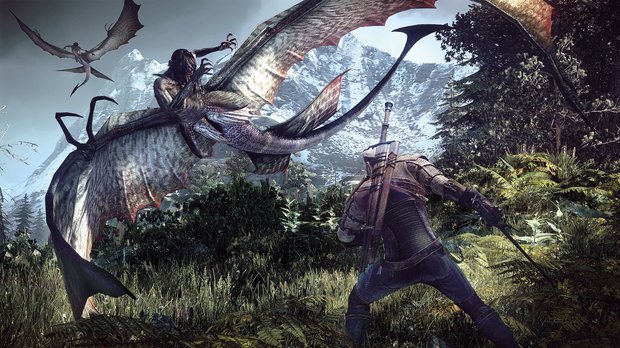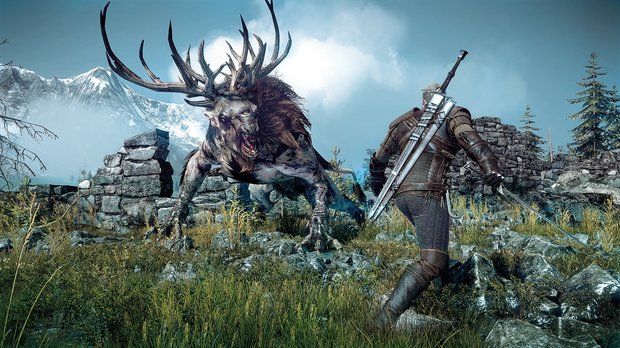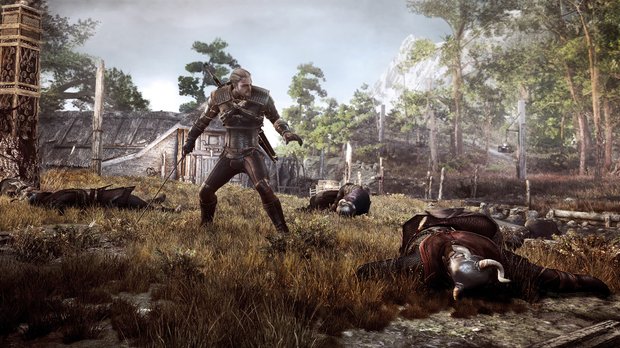The Witcher 3 is an excellent RPG, but its combat system has come under fire from many people for being too easy, too difficult, too clumsy, too lightweight. These people are wrong. I've been interested in sword-fighting both real and virtual for some time, and three years ago I took up historical longsword training in order to better understand the mechanics of it. In my view, CDProjekt has created a fascinating blend of authentic and fictional swordplay, one which rethinks several recently established frameworks for melee combat, resulting in a coherent fighting style specific to the needs of your character.

Before we go into the Witcher 3 specifically, it's worth briefly going over the difficulties that melee combat poses when recreated in a game. From a developer perspective, sword-fighting is one of the hardest things to represent virtually. It's is an inherently chaotic, analogue action, where every strike, every clash of blades, can happen at a different speed or a different angle. Gaming, on the other hand, is a digital form where specific button presses demand exact responses. You click, you swing. You press X, you block.
I don't want to go into too much detail about this here, but the short version is that the two are not at all compatible. Consequently, any attempt to represent sword-fighting in games is immediately intriguing, and the Witcher is a particularly interesting case because of how the combat has evolved since the first game. Over the course of the series, CD Projekt have experimented with different systems, and gradually built toward an engaging and authentically based fighting style. They've consulted with experts who have studied Western martial arts extensively in order to better grasp how swords and sword-fighting work, and rebuilt the combat each time in a continuing process to figure out the best way to portray swordplay in-game.
To answer the obvious question this raises, no, The Witcher 3 does not provide a realistic representation of swordfighting. There are lots of reasons for this. To start with, it's impossible to depict a realistic sword style when fighting against creatures that don't exist. In addition, no matter how good a swordsman you are, fighting a coordinated group of opponents will almost certainly end up with you dead. Hence the moment you try to portray this, you instantly have to make concessions to realism. Lastly, while I like a lot of what the combat does, one criticism that does stand up is that it is unnecessarily flashy, with lots of impressive but impractical pirouetting.

That said, there are some authentic touches that help ground the combat. For example, an enemy holding a shield is very difficult to defeat using just your sword. You need to either wait for them to attack and counter it to create an opening, or use your Signs to otherwise disorient or disable them. Similarly, you can't use your sword to block a strike from an opponent wielding a poleaxe, which is sensible because it's a poleaxe.
Most of all, what I like about the Witcher 3's representation of swords is it recognises that they are sharp. One of the weirdest accusations I've heard directed towards Wild Hunt's combat was that it is lightweight. Swords aren't heavy. They don't need to be. A good longsword weighs around three to four pounds, and the length of the blade generates an incredible amount of leverage when swung. Consider how easy it is to slice carrots with a sharp kitchen knife, and then add a three-foot pivot to the handle. Yeah.
The Witcher 3 is one of the only games to successfully communicate this lightness, this efficiency. Not simply in its grislier moments, but in how Geralt moves lightly on his feet and wields his blade with such ease. It isn't like a big club he uses to bludgeon opponents with, as you might see in Skyrim or a lot of JRPGs. It's more like an extension of his arm, easy to hold, to adjust, and to strike with. Sword-fighting is all about skill, not strength, and Geralt epitomises this notion when he fights.
Weekly digests, tales from the communities you love, and more

That said, there's more to virtual sword-fighting that how the art is represented by the developers. Equally important is how engaging it is from the player's perspective. As already mentioned, reducing the nuances of swordplay to a sequence of button presses is tough, and The Witcher 3's combat isn't just about swords. Geralt also uses signs, bombs, potions, blade oils, and secondary weapons like the crossbow to gain an advantage over his adversaries.
That's a lot of moving parts. But importantly, all of these have varying effects on different enemy types. A large part of the Witcher combat style is adjusting to whatever opponent you're facing, exploiting vulnerabilities through combinations of oils, potions and bombs. It's true that on easier difficulties you can bypass a lot of this, and casually hack your way through the combat. But that's the point of easy mode - to let players enjoy a game without requiring enormous skill or knowledge to do so. On harder difficulties, you need to prepare for fights accordingly, to learn the weaknesses of the monsters you face, and ensure you have a good stock of bombs and potions available at all times.
The variable nature of Witcher combat is also represented when a fight begins. Counters work differently depending on whether you're fighting a human or a monster, and you can't rely on blocking with your sword if a ten-foot-high Fiend charges at you. The game could explain these subtle changes a little better than it does, but there's always an inherent logic to them. There's no point fighting a pack of wolves in the same way you'd fight a man wielding a club, so the game adjusts accordingly, and if you try to block a strike from a monster that would easily shatter all the bones in your arm, well, the game is going to punish you for it.

Blocking isn't a huge part of Geralt's style anyway. Most enemies you fight attack in groups and don't use weapons, so the game places a greater emphasis on avoiding attacks entirely. To that end, Wild Hunt provides you with two evasive manoeuvres, a short-range sidestep, and a longer-range roll. Mastering these two moves is crucial to getting the most out of the game's combat. The sidestep is best used to create an opening from which to attack, while the roll is for getting out of dodge fast, when multiple enemies close in for the kill.
These moves allow CD Projekt to recreate some of the natural chaos of melee combat. Wild Hunt's combat lacks a predictable rhythm, and though games like Arkham Asylum might have taught you otherwise, believe me when I say this is a good thing. Enemies attacking in numbers actually take advantage of those numbers from time to time, striking as soon as they get close rather than waiting until everyone else has taken their turn. This is why the roll is so important. Springing Geralt a good distance from his opponents, it helps to spread them out, lending him more time to pick off individuals. The lack of a Batman style rhythm makes the combat more difficult to grasp, but it's also more satisfying when you emerge victorious, because you need to pay attention to where opponents are and what they are doing, rather than simply responding to the beats the game lays down.

Games are still a long way from perfecting melee combat. But they are getting better, and we are seeing certain approaches taking root, like Batman's crowd control or Dark Souls' roll-or-die. Yet the most exciting thing is there is no established formula yet. Developers are still experimenting with ideas, and more importantly, thinking about how to create a system that best fits their game, rather than how to implement an existing system into their game. And what's most satisfying about the Witcher 3's combat is that it is unique to Geralt. It's more than a cut-and-paste, hack 'n' slash minigame intended to split up the talky bits. It's a specific style designed to cater for a broad range of purposes, one that blends Sapkowski's fiction with the logic of swordplay to create something you won't see anywhere else.
Rick is the Games Editor on Custom PC. He is also a freelance games journalist whose words have appeared on Eurogamer, PC Gamer, The Guardian, RPS, Kotaku, Trusted Reviews, PC Gamer, GamesRadar, Rock, Paper, Shotgun, and more.


